Wireless Standards |
RFID | Wireless | Mobility |
Different methods and standards of wireless communication have developed across the world, based on various commercially driven requirements. These technologies can roughly be classified into four individual categories, based on their specific application and transmission range. These categories are summarised in the figure below.
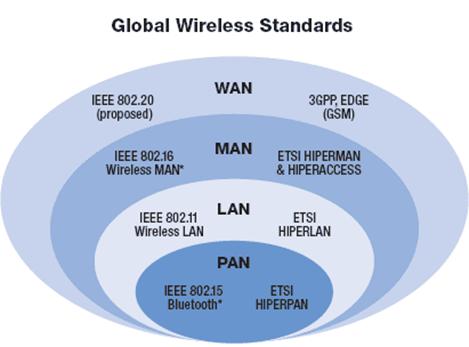
Personal Area Network (PAN)
A Personal Area Network (PAN) is a computer network used for communication among computer devices (including telephones and personal digital assistants) close to one person. The reach of a PAN is typically a few meters. PAN’s can be used for communication among the personal devices themselves (intrapersonal communication), or for connecting to a higher level network and the Internet.
Personal area networks may be wired with computer buses such as USB and FireWire. However, a Wireless Personal Area Network (WPAN) is made possible with network technologies such as Infrared (IrDA) and Bluetooth.
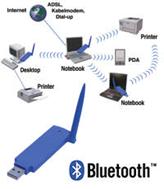
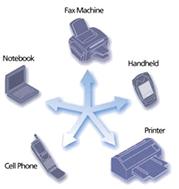
- Bluetooth: Bluetooth is an industrial specification for wireless personal area networks (PANs), also known as IEEE 802.15.1. Bluetooth provides a way to connect and exchange information between devices such as personal digital assistants (PDAs), mobile phones, laptops, PCs, printers, digital cameras and video game consoles via a secure, globally unlicensed short-range radio frequency.
Bluetooth is a radio standard and communications protocol primarily designed for low power consumption, with a short range (power class dependent: 1 metre, 10 metres, 100 metres) based around low-cost transceiver microchips in each device.
- Infrared (IrDA): The Infrared Data Association (IrDA) defines physical specifications communications protocol standards for the short range exchange of data over infrared light, for typical use in Personal Area Networks.
Local Area Network (LAN)
A wireless LAN or WLAN is a wireless Local Area Network, which is the linking of two or more computers without using wires. It uses radio communication to accomplish the same functionality that a wired LAN has. WLAN utilizes spread-spectrum technology based on radio waves to enable communication between devices in a limited area, also known as the basic service set. This gives users the mobility to move around within a broad coverage area and still be connected to the network.
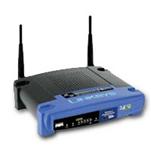
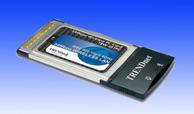
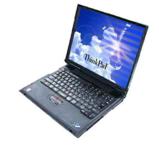
- IEEE 802.11: IEEE 802.11, the Wi-Fi standard, denotes a set of Wireless LAN/WLAN standards developed by working group 11 of the IEEE LAN/MAN Standards Committee (IEEE 802). The 802.11 family currently includes six over-the-air modulation techniques that all use the same protocol. The most popular (and prolific) techniques are those defined by the b, a, and g amendments to the original standard.

The table below summarises the different 802.11 standards:
Protocol |
Release Date |
Op. Frequency |
Data Rate (Typical) |
Data Rate (Max) |
Range (Indoor) |
Legacy |
1997 |
2.4 -2.5 GHz |
1 Mbit/s |
2 Mbit/s |
? |
802.11a |
1999 |
5.15-5.35/5.47-5.725/5.725-5.875 GHz |
25 Mbit/s |
54 Mbit/s |
~30 meters (~100 feet) |
802.11b |
1999 |
2.4-2.5 GHz |
6.5 Mbit/s |
11 Mbit/s |
~50 meters (~150 feet) |
802.11g |
2003 |
2.4-2.5 GHz |
11 Mbit/s |
54 Mbit/s |
~30 meters (~100 feet) |
802.11n |
2006 (draft) |
2.4 GHz or 5 GHz bands |
200 Mbit/s |
540 Mbit/s |
~50 meters (~160 feet) |
Metropolitan Area Network (MAN)
Wireless Metropolitan Area Network (MAN) is the name trademarked by the IEEE 802.16 Working Group on Broadband Wireless Access Standards for its wireless metropolitan area network standard (commercially known as WiMAX), which defines broadband Internet access from fixed or mobile devices via antennas. Subscriber stations communicate with base-stations that are connected to a core network. This is a good alternative to fixed line networks and it is simple to build and relatively inexpensive.
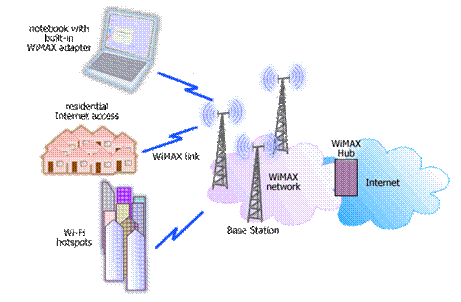
- WiMAX: WiMAX is defined as Worldwide Interoperability for Microwave Access by the WiMAX Forum, formed in June 2001 to promote conformance and interoperability of the IEEE 802.16 standard, officially known as WirelessMAN. The Forum describes WiMAX as "a standards-based technology enabling the delivery of last mile wireless broadband access as an alternative to cable and DSL".
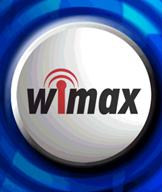
The range of WiMAX probably generates more confusion than any other single aspect of WiMAX. It is common to see statements in the media describing WiMAX multipoint coverage extending 30 miles. In a strict technical sense (in some spectrum ranges) this is correct, with even greater ranges being possible in point to point links. In practice in the real world (and especially in the license-free bands) this is wildly overstated especially where non line of sight (NLOS) reception is concerned.
Due to a variety of factors, the average cell ranges for most WiMAX networks will likely boast 4-5 mile range (in NLOS capable frequencies) even through tree cover and building walls. Service ranges up to 10 miles (16 Kilometers) are very likely in line of sight (LOS) applications (once again depending upon frequency). Ranges beyond 10 miles are certainly possible but for scalability purposes may not be desirable for heavily loaded networks. In most cases, additional cells are indicated to sustain high quality of service (QOS) capability. For the carrier class approach, especially as regards mobility, cells larger than this seem unlikely in the near future.
Wide Area Network (WAN)
A Wide Area Network or WAN is a computer network covering a broad geographical area. Contrast with personal area networks (PAN’s), local area networks (LAN’s) or metropolitan area networks (MAN’s) that are usually limited to a room, building or campus. The largest and most well-known example of a WAN is the Internet.
WAN’s are used to connect local area networks (LAN’s) together, so that users and computers in one location can communicate with users and computers in other locations. Many WAN’s are built for one particular organisation and are private. Others, built by Internet service providers, provide connections from an organisation's LAN to the Internet.
In addition, WAN’s also refer to Mobile Data Communications, such as GSM, GPRS and 3G. Please refer to our Mobility section for further details.
Technology Summary
These wireless communication technologies evolved over time to enable the transmission of larger amounts of data at greater speeds across a global network. The following figure summarises the technical details of each cluster of technologies.
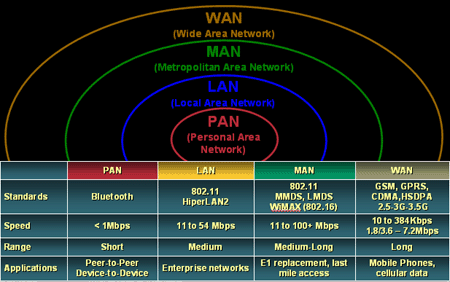
Standards | Elements | Devices | Business Benefits | The RFID Centre and Wireless


